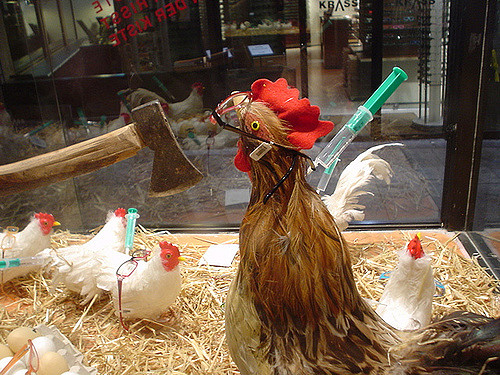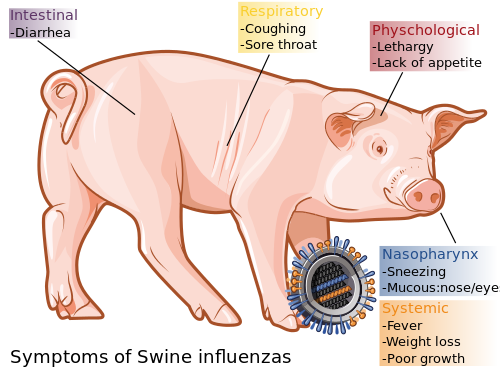Difference Between Bird Flu and Swine Flu
What is Bird Flu?
Bird flu (H5N1) is a type A influenza, causing an infection that most commonly affects wild birds. The infection can also spread to poultry. In rare cases, the virus can cause disease in people who have direct contact with sick birds.
A source of infection in humans are birds carrying the virus – domestic or wild (mainly waterfowl). Infected birds release the virus with saliva, nasal discharge, and feces.

Bird flu can cause serious illness and death. People can become infected with the virus by:
- Direct contact with infected birds (sick or carriers of the virus);
- Contact with objects and surfaces contaminated by infected birds;
- Contact with secretions and feces, where the concentration of the virus is very high
It is considered that risk exists also in the consumption of non-thermally processed poultry products.
The risk of bird flu development is higher in people who:
- Work in poultry farms;
- Work with raw poultry materials;
- Travel/live in countries affected by bird flu;
- Consume thermally untreated poultry products;
- Have been in contact with an infected bird.
H5N1 virus infection is associated with the following influenza-specific symptoms:
- Fever;
- Cough (most often dry) and difficult breathing;
- Nausea;
- General fatigue;
- Muscle pain;
- Headache;
- Diarrhea;
- Sore throat;
- Conjunctivitis.
The potential complications of bird flu include:
- Pneumonia;
- Sepsis;
- Organ failure.
Pneumonia resulting from bird flu is aggressive and leads to the development of the so-called acute respiratory distress syndrome.
Nearly 60% of the patients with bird flu develop complications.
Currently, the specific bird flu prophylaxis through vaccines is limited mainly to people at risk of contagion. The prevention includes a set of non-specific measures:
- Avoid direct contact with wild and domestic birds;
- Do not touch objects and surfaces contaminated with bird feces or secretions;
- Maintain very good personal hygiene;
- Do not consume raw poultry products.
Antivirus therapy is performed with Oseltamivir and Zanamivir.
The symptomatic remedies for the treatment of bird flu are basically the same as for any other influenza infection – antipyretics, anti-cough remedies, vitamins, as well as a suitable home or hospital regime.

What is Swine Flu?
Swine flu (H1N1) is a type A influenza, affecting pigs, or a form of human flu, caused by a related virus. In the past it affected only by people, having direct contact with pigs. Several years ago a new virus emerged that spreads among people, without contact with pigs.
Most of the affected people are between 5 and 45 years old.
It is considered that the virus is no more dangerous than a common influenza virus.
The severity of the disease ranges from very mild to severe cases leading to death. Most people infected with swine flu are recovering without antiviral treatment and medical care.
The virus spreads from person to person. The infection is transmitted easily, via droplets, coughing or sneezing, it is inhaled or transmitted by hands that have previously touched contaminated surfaces.
Sick people can infect others within 7 days after the symptoms have occurred.
The symptoms of swine flu include:
- Fever;
- Cold chills;
- General fatigue;
- Cough (most often dry) and difficult breathing;
- Pain in joints and muscles;
- Eye pain;
- Muscle pain;
- Headache;
- Diarrhea and vomiting.
The symptoms of swine flu are similar to the symptoms of other flu types. Only a test can indicate the type of virus. The H1N1 virus is demonstrated by the polymerase chain reaction method that detects its nucleic acids.
One of the most common complications of swine flu is the development of pneumonia.
Other complications include:
- Angina;
- Otitis media;
- Septic shock;
- Meningitis;
- Encephalitis.
Vaccination is the most effective way to prevent swine flu and is widely used.
Swine flu prevention includes a set of non-specific measures:
- Avoid confined spaces with many people;
- Wear a mask when you are in a confined space;
- Maintain very good personal hygiene;
- Avoid contact of hands with eyes and mouth;
- Try to avoid contact with sick people;
In most cases, symptomatic remedies, fluid intake, and rest are sufficient treatment for the swine flu. It is successfully treated with Oseltamivir and Zanamivir, but such treatment is only necessary if there is a risk of developing complications.
Difference Between Bird Flu and Swine Flu
-
Definition
Bird Flu: Bird flu (H5N1) is a type A influenza, causing an infection that most commonly affects wild birds.
Swine Flu: Swine flu (H1N1) is a type A influenza, affecting pigs, or a form of human flu, caused by a related virus.
-
Etiology
Bird Flu: A source of infection in humans are birds carrying the virus – domestic or wild.
Swine Flu: In the past a source of infection in humans were infected pigs. Several years ago a new virus emerged that spreads among people, without contact with pigs.
-
Occurrence
Bird Flu: The risk of bird flu development is higher in people who work in poultry farms or with raw poultry materials, travel/live in countries affected by bird flu, consume thermally untreated poultry products, have been in contact with an infected bird.
Swine Flu: Most of the affected people are between 10 and 45 years old.
-
Spread
Bird Flu: People can be infected with the virus by direct contact with infected birds, contact with objects and surfaces contaminated by infected birds, contact with secretions and feces, and in very rare cases – in close contact with sick people. It is considered that risk exists also in the consumption of non-thermally processed poultry products.
Swine Flu: The virus spreads from person to person. The infection is transmitted via droplets, coughing or sneezing, it is inhaled or transmitted by hands that have previously touched contaminated surfaces.
-
Prevention
Bird Flu: The prevention of bird flu includes avoiding direct contact with wild and domestic birds, not touching objects and surfaces contaminated with bird feces or secretions, maintaining a very good personal hygiene, not consuming raw poultry products.
Swine Flu: Swine flu prevention includes avoiding confined spaces with many people, wearing a mask, maintaining very good personal hygiene, avoiding contact of hands with eyes and mouth, avoiding contact with sick people.
-
Vaccines
Bird Flu: Currently, the specific bird flu prophylaxis through vaccines is limited mainly to people at risk of contagion.
Swine Flu: Vaccination is the most effective way to prevent swine flu and is widely used.
-
Prognosis
Bird Flu: Nearly 60% of the patients with bird flu develop severe complications and die.
Swine Flu: It is considered that the swine flu is no more dangerous than a common influenza virus.
Bird Flu Vs. Swine Flu: Comparison Chart

Summary of Bird Flu Vs. Swine Flu:
- Bird flu (H5N1) is a type A influenza, causing an infection that most commonly affects wild birds.
- Swine flu (H1N1) is a type A influenza, affecting pigs, or a form of human flu, caused by a related virus.
- A source of bird flu infection in humans are birds carrying the virus – domestic or wild. A source of swine flu infection in humans in the past were pigs. Several years ago a new virus emerged that spreads among people.
- The risk of bird flu development is higher in people who work in poultry farms or with raw poultry materials, travel/live in countries affected by bird flu, consume thermally untreated poultry products, have been in contact with an infected bird. Swine flu affects mostly people between 10 and 45 years old.
- People can be infected with bird flu by direct contact with infected birds, contact with objects and surfaces contaminated by infected birds, contact with secretions and feces, etc. The swine flu spreads from person to person via droplets.
- The prevention of bird flu includes avoiding direct contact with wild and domestic birds, not touching objects and surfaces contaminated with bird feces or secretions, maintaining a very good personal hygiene, not consuming raw poultry products. Swine flu prevention includes avoiding confined spaces with many people, wearing a mask, maintaining very good personal hygiene, avoiding contact of hands with eyes and mouth, avoiding contact with sick people.
- The bird flu prophylaxis through vaccines is limited mainly to people at risk of contagion. Swine flu vaccination is the most effective way to prevent the disease and is widely used.
- Nearly 60% of the patients with bird flu develop severe complications and die. The swine flu is no more dangerous than a common influenza virus.
- Difference Between Gallstones and Cholecystitis - September 5, 2021
- Difference Between Constipation and Cramping - August 4, 2021
- Difference Between Whole Genome Sequencing and Microarray - May 6, 2021
Search DifferenceBetween.net :
1 Comment
Leave a Response
References :
[0]Siegel, M. Swine Flu: The New Pandemic. New York: Wiley. 2009. Print.
[1]Stones, M. Bird Flu Pandemic. Bloomington: iUniverse. 2006. Print.
[2]Wiwanitkit. V. Swine Flu and Pig Borne Diseases. New York: Nova Biomedical Books. 2009. Print.
[3]Image credit: https://upload.wikimedia.org/wikipedia/commons/thumb/1/19/Swine_influenza_symptoms_on_swine-en.svg/500px-Swine_influenza_symptoms_on_swine-en.svg.png
[4]Image credit: https://www.flickr.com/photos/celesteh/132968090

I want to know if iam affected of swine flu and bird flu bcos sometimes i feel like a symtoms of flu. Sometimes i have a little fever il take biogesic i feel my body is strong,,, now i feel pain in my left head. Ive no money to go to the doctor to check up… my name is imelda jimenez,felix goniabo. Im here in bcda mb4 room 211 taguig city philippines.